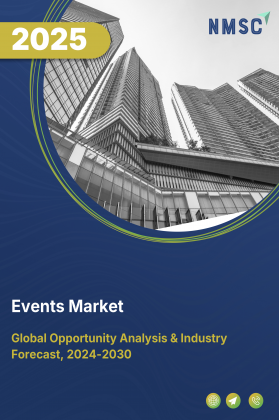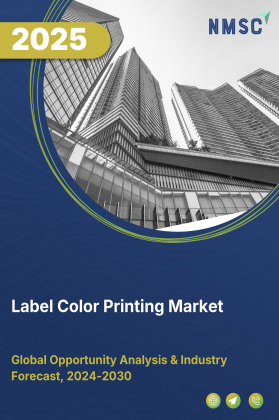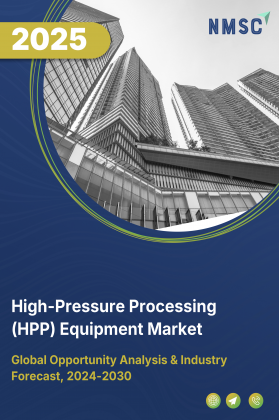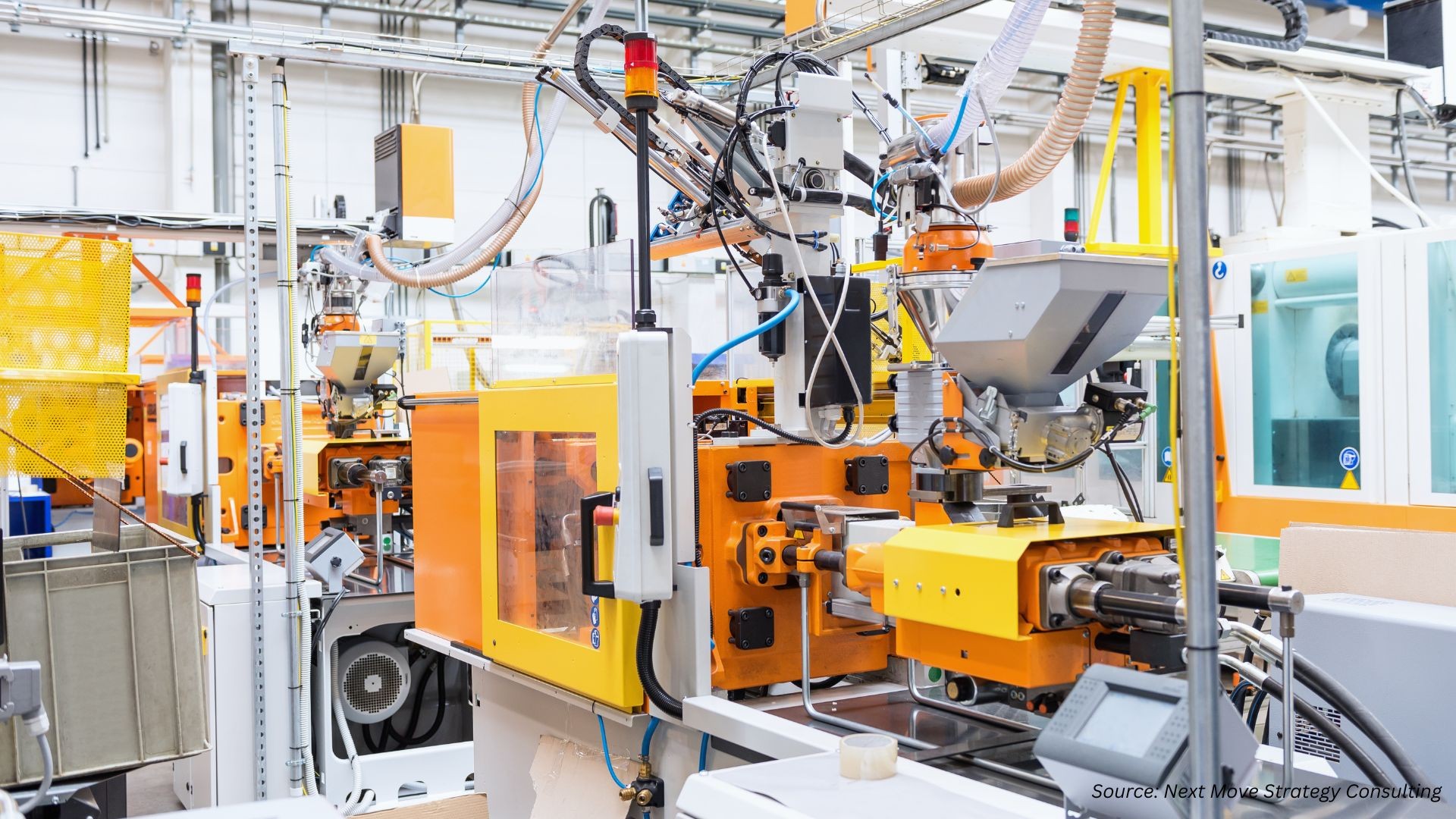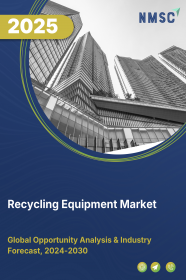
Recycling Equipment Market by Equipment Type (Sorting & Separation, Shredding & Size Reduction Equipment, Conveying & Feeding Systems, Extrusion & Pelletizing Systems and Others), by Material Type (Plastic, Metal, Paper, Glass, Rubber & Tire, C&D Waste, E-Waste, Organic, Textile, Composite, Others), by End User – Global Opportunity Analysis and Industry Forecast, 2025–2030
Industry Overview
The global Recycling Equipment Market size was valued at USD 31.3 billion in 2024 and is expected to reach USD 32.3 billion by the end of 2025. The industry is predicted to reach USD 42.8 billion by 2030 with a CAGR of 5.6% from 2025-2030.
The market is experiencing sustained momentum, propelled primarily by increasingly stringent environmental regulations and evolving waste management frameworks. Governments and regulatory bodies worldwide are compelling industries to embrace sustainable practices, which is stimulating demand for specialized recycling technologies.
Simultaneously, urbanization and industrialization are accelerating waste generation, intensifying the need for efficient and scalable recycling infrastructure. As industries shift toward sustainable production, the requirement for high-purity recycled raw materials is further amplifying market demand.
However, high capital and operational costs present notable challenges, particularly for smaller enterprises. Nonetheless, technological advancements and automation integration are opening new avenues for efficiency, precision, and scalability, positioning the market for continued growth amid global environmental priorities.
Growing Environmental Regulations and Waste Management Policies Fuels the Market Growth
The global recycling equipment market is witnessing robust growth, significantly driven by the tightening of environmental regulations and the implementation of structured waste management policies. Governments across the globe are enforcing stricter mandates on industries to reduce landfill use and ensure sustainable resource recovery, which in turn is fueling the demand for efficient and specialized recycling technologies.
In 2024, India’s Ministry of Environment, Forest and Climate Change (MoEFCC) introduced a landmark regulatory push toward a circular economy by strengthening Extended Producer Responsibility (EPR) norms across multiple waste streams. These include plastic waste, tyre waste, battery waste, used oil, and e-waste each requiring specific equipment such as shredders, sorters, crushers, and washing systems for effective recycling. Such comprehensive policies are creating long-term opportunities for equipment manufacturers offering solutions aligned with environmental compliance.
Urbanization and Industrial Growth Fuel Demand for Advanced Recycling Equipment
The surge in urban development and industrialization is contributing to a sharp increase in waste generation, intensifying the demand for efficient recycling solutions. This has created a significant market opportunity for modern recycling equipment that can handle large volumes of diverse waste streams. As municipalities and industries strive to build scalable, sustainable waste management systems, the adoption of advanced recycling machinery has become essential.
According to UNEP’s Global Waste Management Outlook 2024, municipal waste is expected to grow from 2.3 billion tonnes in 2023 to 3.8 billion tonnes by 2050. If left unaddressed, the total cost of waste, including environmental and health impacts, could soar to USD 640.3 billion annually by 2050—underscoring the urgent need for investment in high-efficiency recycling equipment and infrastructure.
Growing Demand for Recycled Raw Materials Accelerates Adoption of Advanced Recycling Equipment
With industries embracing more sustainable production practices, the global need for recycled raw materials is rising sharply. This shift is driving strong demand for high-performance recycling equipment capable of producing high-quality secondary raw materials.
Key sectors such as automotive, packaging, electronics, and construction are under mounting regulatory and consumer pressure to increase the use of recycled content. As a result, manufacturers are investing in technologically advanced recycling machinery to meet quality standards, improve material recovery rates, and ensure compliance—thereby fueling growth across the sustainable processing.
High Costs Restrain the Market Expansion
The market faces significant challenges due to the substantial upfront investment required for purchasing advanced machinery. Additionally, ongoing operational and maintenance expenses add to the financial burden, particularly for small and medium enterprises with limited capital. These high costs deter businesses from adopting modern recycling technologies, especially in developing or cost-sensitive regions where budget constraints are more pronounced.
Technological Advancements and Automation Integration Creates Opportunity for the Market Growth
The integration of AI, IoT, and automation into recycling equipment offers significant potential to improve sorting accuracy, reduce labor dependency, and increase throughput. According to the IEA Bioenergy report (2024), advanced sorting technologies, such as sensor-based optical sorters, AI-driven robotic arms, and automated quality control systems, enable more precise identification and separation of diverse waste materials. This leads to higher purity of recycled outputs, reduced contamination rates, and enhanced material recovery.
A striking example is Veolia’s deployment of an AI-guided robotic arm, in collaboration with Recycleye, at its Southwark Integrated Waste Management Facility in London in June 2024. The robot autonomously identifies and removes paper, card, mixed plastics, and beverage cartons from aluminium recovery lines, boosting sorting precision by achieving 35–50 picks per minute, reducing contamination, and feeding sorted data to cloud dashboards for real-time operational optimization
Market Segmentation and Scope of the Study
The recycling equipment market report is segmented by equipment type, material type, and end users. Equipment types include sorting and separation (optical, magnetic, eddy current sorters), shredding and size-reduction (industrial shredders, granulators, crushers), baling and compacting (vertical, and others), conveying systems, washing and drying units, extrusion and pelletizing machines, crushing and milling equipment and others. Material types cover plastics, metals, paper, glass, rubber and others. End users span municipal sectors (MRFs, composting, waste-to-energy), recycling companies, construction recyclers, automotive and industrial processors, e-waste specialists, plastics and packaging industries, paper and packaging recyclers, glass processors, textile recyclers, bioenergy producers, industrial manufacturers, and infrastructure contractors.
Geographical Analysis
North America plays a major role in the global recycling equipment market share, supported by strong policies, significant infrastructure investments, and a growing commitment to the circular economy. In the U.S. and Canada, government initiatives are driving demand for advanced technologies such as balers, MRFs, organics processing systems, and battery recycling solutions.
A recent example is the EPA’s launch of the Extended Producer Responsibility (EPR) Framework for Batteries in April 2025, which defines national standards for battery collection, transport, and labeling. This policy is directly stimulating demand for battery-specific recycling equipment, including secure containers and modular sorting systems. This policy-driven momentum, supported by federal and provincial funding programs, is not only enhancing operational capacity but also encouraging innovation across the recycling value chain.
Europe continues its leadership in recycling innovation, driven by the EU’s Circular Economy Action Plan. In Germany and the Netherlands, manufacturers and municipalities are investing in optical sorters, balers, and sensor-based machines to comply with rising recycled-content mandates. A notable public–private collaboration is the Fraunhofer IFF’s 2024–25 iDEAR project (Intelligent Disassembly of Electronics for Remanufacturing and Recycling), which integrates AI-powered 3D vision and robotics to automate precision dismantling of e-waste, successfully demonstrating motherboard removal from PCs and preparing the system for broader applications.
Asia Pacific is witnessing strong growth, supported by rapid urbanization and evolving policies in China, India, and Southeast Asia. For example, in India, city governments such as Delhi and Mumbai have launched e waste initiatives in 2025, including eco parks capable of processing tens of thousands of tonnes per year under public–private partnerships to include dismantling and refurbishing facilities.
Complementing this trend, Thailand announced in March 2024 the establishment of a Special Economic Zone (SEZ) in Chachoengsao province dedicated to clean energy development, including battery production infrastructure to support the country’s rapidly expanding EV industry. This policy-driven investment is expected to stimulate demand for battery-specific recycling and disassembly equipment, further reinforcing Southeast Asia’s growing role in the regional recycling technology landscape.
In the Rest of the World (ROW), spanning Latin America, the Middle East, and Africa, recycling infrastructure is advancing through strategic, localized investments. In São Paulo, Brazil, municipal authorities launched a national urban organic waste strategy in 2024, aiming to divert approximately 45% of urban waste (estimated at around 64 million tonnes in 2022) from landfills into composting and biogas facilities. This initiative exemplifies a growing regional commitment to sustainable waste management, supported by increased deployment of modern recycling equipment, and signals a broader shift toward circular economy practices across the developing world.
Strategic Innovations Adopted by Key Players
The key companies in the recycling equipment industry are leading innovation through automation, AI integration, and energy-efficient machinery to meet the rising demand for sustainable waste management solutions. These players are actively investing in R&D and global expansion to offer advanced sorting, shredding, and material recovery systems across multiple waste streams.
In May 2025, TOMRA Systems ASA launched its next-generation X-TRACT unit designed specifically for wood recycling applications. The advanced system enhances material purity and recovery efficiency, reflecting the company's continued innovation in sensor-based sorting technologies. This development underscores the growing need for specialized recycling equipment capable of handling diverse waste streams and highlights TOMRA's strategic focus on meeting industry demands for high-performance, sustainable material recovery solutions.
Similarly, in 2024, Vecoplan AG launched an extensive investment initiative of 13 million Euros to expand its headquarters in Bad Marienberg, Germany, which included upgrading production lines and introducing the innovative VIZ 1300 shredder to enhance material processing capabilities.
Eldan Recycling bolstered its international presence through active participation in industry expos such as the Australasian Waste & Recycling Expo (AWRE) in Sydney, showcasing its advanced systems for tires, cables, and e-waste, and signaling its intent to capture emerging markets.
Meanwhile, in 2025, ANDRITZ Group broadened its recycling portfolio by acquiring ATN Engineering B.V., adding refrigerant recycling capabilities, and partnering with HolyPoly to offer circular recycling solutions for paper machine clothing, underscoring its dedication to sustainable industrial transformation.
Key Benefits
-
The report provides quantitative analysis and estimations of the recycling equipment market from 2025 to 2030, which assists in identifying the prevailing industry opportunities.
-
The study comprises a deep-dive analysis of the Zero waste initiatives including the current and future recycling equipment market trends to depict prevalent investment pockets in the industry.
-
Information related to key drivers, restraints, and opportunities and their impact on the market is provided in the report.
-
Competitive analysis of the key players, along with their market share is provided in the report.
-
SWOT analysis and Porters Five Forces model is elaborated in the study.
-
Value chain analysis in the market study provides a clear picture of roles of stakeholders.
Recycling Equipment Market Key Segments
By Equipment Type
-
Sorting & Separation Equipment
-
Optical Sorters
-
Magnetic Separators
-
Eddy Current Separators
-
Air Classifiers / Density Separators
-
Vibratory Screens / Shaking Screens
-
Trommel Screens / Drum Screens
-
Sensor-based / X-ray / Laser Sorters
-
Water-based Separation Systems
-
-
Shredding & Size Reduction Equipment
-
Industrial Shredders
-
Single-shaft Shredders
-
Dual-shaft Shredders
-
Quad-shaft Shredders
-
-
Granulators
-
Hammer Mills
-
Shears / Guillotines
-
Crushers
-
Jaw Crushers
-
Impact Crushers
-
Cone / Roller Crushers
-
-
-
Baling, & Densification Equipment
-
Vertical Balers
-
Horizontal Balers
-
Two-Ram (Dual-Ram) Balers
-
Briquetting Machines
-
Hydraulic Briquetters
-
Screw-press Densifiers
-
-
Agglomerators
-
-
Conveying & Feeding Systems
-
Belt Conveyors
-
Chain Conveyors
-
Pneumatic Conveyors
-
Vibratory Feeders / Bowl Feeders
-
Screw Conveyors / Augers
-
-
Washing, Rinsing & Drying Equipment
-
Washing Lines
-
Friction Washers
-
Hot-wash Tanks
-
Float/Sink Tanks
-
-
Rinse Tanks & Filtration Systems
-
Dryers / Dewatering Equipment
-
- Extrusion & Pelletizing Systems
-
Extruders
-
Single-Screw Extruders
-
Twin-Screw Extruders
-
-
Strand Pelletizers
-
Compounding Lines
-
- Crushing & Milling Equipment
-
Fine Crushers
-
Cryogenic Mills / Granulators
-
Disc Mills / Bead Mills
-
-
Chemical Recycling & Pyrolysis Systems
-
Pyrolysis Reactors
-
Depolymerization / Solvolysis Units
-
Gasification Systems
-
Catalytic Cracking / Hydro-treatment Reactors
-
- Specialized Equipment
-
E-Waste Recycling Modules
-
PCB Separators
-
Circuit Board Granulators
-
Induction Furnaces
-
Dust & Emission Control Units
-
-
Glass & Ceramic Recycling Systems
-
Glass Crushers / Pulverizers
-
Glass Washing Lines
-
Ceramic & Tile Crushers
-
-
Organic & Biomass Processing
-
Anaerobic Digesters / Biogas Reactors
-
Compost Turners
-
Biomass Pelletizers
-
-
-
Emerging & Advanced Technologies
-
Laser-based Delamination Systems
-
Cryogenic Freezers (CO₂ / LN₂)
-
Ultrasonic Separators
-
Robotic Sorting Cells
-
AI / Machine-Vision Inspection Systems
-
Circular Economy Monitoring Platforms
-
By Material Type
-
Plastic Recycling Equipment
-
Metal Recycling Equipment
-
Ferrous Metals (Steel, Iron)
-
Non-Ferrous Metals (Aluminum, Copper, Brass, Lead)
-
-
Paper & Cardboard Recycling Equipment
-
Glass Recycling Equipment
-
Rubber & Tire Recycling Equipment
-
Construction & Demolition (C&D) Waste Recycling Equipment
-
Electronic Waste (E-Waste) Recycling Equipment
-
Organic & Biomass Recycling Equipment
-
Textile & Fiber Recycling Equipment
-
Composite & Multilayer Material Recycling Equipment
-
Battery Recycling Equipment (e.g., Lithium-ion)
-
Other Specialty Materials (e.g., Foam, Carpet, Insulation)
By End User
-
Municipal & Government Sector
-
Material Recovery Facilities (MRFs)
-
Public Composting / Biogas Facilities
-
RDF/SRF Producers (Waste-to-Energy)
-
-
Waste Management & Recycling Companies
-
Construction & Demolition Industry
-
C&D Waste Recyclers
-
Concrete / Brick Crushers
-
Wood Waste Recyclers
-
-
Automotive & Industrial Sector
-
ELV Dismantlers
-
Tire Recycling Plants
-
-
Electronics & Battery Recyclers
-
Consumer Electronics Recyclers
-
Battery Reprocessing Facilities
-
-
Packaging & Plastics Industry
-
PET Bottle Reclaimers
-
Rigid Container Recyclers
-
-
Paper & Cardboard Sector
-
Paper Mills
-
Corrugated Box Manufacturers
-
-
Glass & Ceramic Industry
-
Glass Reclaimers
-
Ceramic Product Recyclers
-
-
Textile & Apparel Industry
-
Bioenergy & Biomass Producers
-
Manufacturing & Industrial In-House Recycling
By Region
-
North America
-
The U.S.
-
Canada
-
Mexico
-
-
Europe
-
The U.K.
-
Germany
-
France
-
Italy
-
Spain
-
Denmark
-
Netherlands
-
Finland
-
Sweden
-
Norway
-
Russia
-
Rest of Europe
-
-
Asia-Pacific
-
China
-
Japan
-
India
-
South Korea
-
Australia
-
Indonesia
-
Singapore
-
Taiwan
-
Thailand
-
Rest of Asia-Pacific
-
-
RoW
-
Latin America
-
Middle East
-
Africa
-
Key Players
-
TOMRA Systems ASA
-
Vecoplan AG
-
SSI Shredding Systems
-
UNTHA shredding technology
-
Eldan Recycling A/S
-
Granutech-Saturn Systems
-
Metso
-
ANDRITZ
-
BHS-Sonthofen GmbH
-
HAMMEL Recyclingtechnik GmbH
-
Herbold Meckesheim GmbH
-
Pellenc ST
-
Bulk Handling Systems
-
CP Manufacturing, Inc.
-
LEFORT | Metal Recycling Equipment
REPORT SCOPE AND SEGMENTATION:
|
Parameters |
Details |
|
Market Size in 2025 |
USD 32.3 Billion |
|
Revenue Forecast in 2030 |
USD 42.8 Billion |
|
Growth Rate |
CAGR of 5.6% from 2025 to 2030 |
|
Analysis Period |
2025–2030 |
|
Base Year Considered |
2024 |
|
Forecast Period |
2025–2030 |
|
Market Size Estimation |
Billion (USD) |
|
Growth Factors |
|
|
Countries Covered |
28 |
|
Companies Profiled |
15 |
|
Market Share |
Available for 10 companies |
|
Customization Scope |
Free customization (equivalent to up to 80 working hours of analysts) after purchase. Addition or alteration to country, regional, and segment scope. |
|
Pricing and Purchase Options |
Avail customized purchase options to meet your exact research nee |

















 Speak to Our Analyst
Speak to Our Analyst



